outweigh noise suppression in the final selection process. The engineers in charge of a particular vehicle model may choose a friction material or pad design based more on high temperature fade resistance or its wear characteristics than its acoustical properties. Consequently, the brakes on some new cars and trucks may be noisier than some people would prefer.
Semi-metallic pads, with their high steel content, can tolerate a lot of heat without fading. But, their high metallic content often makes the pads much more prone to squealing when the brakes are applied.
Noise is the result of high frequency vibrations between the pads, caliper and rotor. When the stationary pads rub 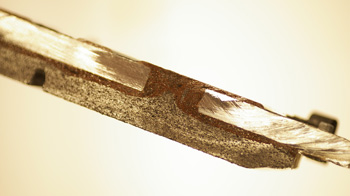 against a spinning rotor, they glide like a hockey puck on ice. If there is play between the pads and caliper, the pads can chatter and vibrate as they ride over the surface of the rotor. Depending on the frequency of the vibration, this can create a high pitched squeal that really annoys some people.
against a spinning rotor, they glide like a hockey puck on ice. If there is play between the pads and caliper, the pads can chatter and vibrate as they ride over the surface of the rotor. Depending on the frequency of the vibration, this can create a high pitched squeal that really annoys some people.
Nonasbestos organic friction materials and many ceramic-based friction materials, by comparison, use more fillers and tend to be softer and quieter. This helps dampen the vibrations that cause brake squeal. But the trade off may be shorter pad life or less fade resistance, depending on the friction material used.
Tricks that are often used when designing a brake pad is to chamfer the ends and/or add slots to “tune” the pad so it makes less noise. Chamfers and slots change the natural frequency a which the pad oscillates, allowing the pad to run quieter than a pad which lacks these features.
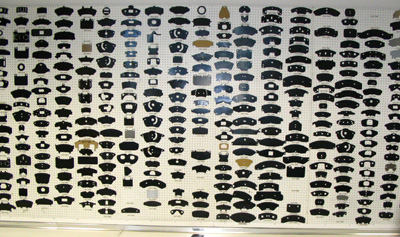 Various types of shims may also be installed on the steel backing plate or molded into the pad itself to further dampen vibrations between the pad and caliper. The shims act like a cushion to absorb noise-producing vibrations.
Various types of shims may also be installed on the steel backing plate or molded into the pad itself to further dampen vibrations between the pad and caliper. The shims act like a cushion to absorb noise-producing vibrations.
Pads may also be supported by anti-rattle clips or springs that minimize play between the pads and caliper and further dampen vibrations during initial engagement of the pad.
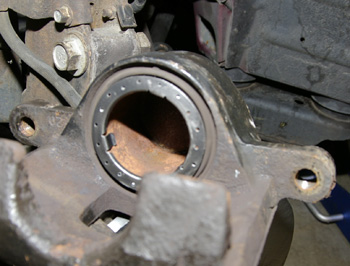
NVH VERSUS PERFORMANCE
The philosophy with some Asian luxury import vehicle manufacturers is that noise control is more important than pad wear or fade resistance. So the OEM friction materials they use are usually very quiet, but may wear at a higher rate than what may be found on many domestic makes.
With European automakers, performance usually takes precedence over noise suppression on many luxury performance sedans and sports coupes. People who buy these kind of vehicles may or may not understand this, and may or may not be happy with the sound of their OEM brakes. They may also be unhappy with the black brake dust many European friction compounds leave on the wheels as the pads wear.
Friction suppliers are constantly developing new friction materials that make fewer compromises. So a pad that’s quiet does not necessarily have to be a pad that doesn’t wear well or perform well. In fact, many premium grade friction materials today do it all quite well. The friction material resists wear and pedal fade, provides great stopping power, and contains the right mix of fillers, lubricants and other ingredients to keep noise and dust to a minimum. Some of these luxury pads can be rather expensive. But for customers who demand the best and don’t want to sacrifice wear or braking performance for noise suppression, premium pads are the way to go.
CONTROLLING NVH WHEN DOING A BRAKE JOB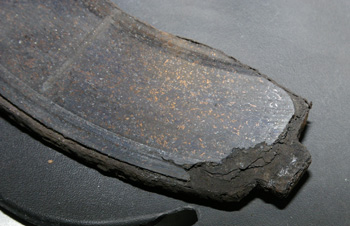
By the time a vehicle has been driven 40,000 to 60,000 miles, the front disc brake pads are usually reaching the end of the road. Most molded brake pads must be replaced when the friction linings are worn down to a thickness of 1/8th inch or less. At this point, the linings are dangerously thin and have an increases risk of cracking or separating from the steel backing plate. The linings may also be worn unevenly or contaminated with brake fluid from a leaky caliper seal. These too, are valid reasons for replacing the pads, regardless of how much friction material is left on the pad.
Your goal as a brake technician is to restore the brakes to like-new (or better than new) condition. That means accessing the condition of the rotors to see if the rotors need to be resurfaced or replaced, checking the condition of the calipers to see if they need to be rebuilt or replaced, and choosing a set of replacement pads that best suit your customer’s preferences and needs.
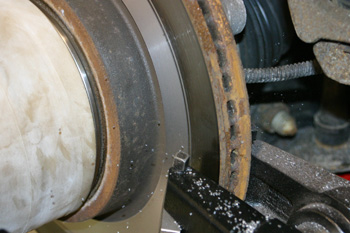 ROTORS: RESURFACE, REPLACE OR LEAVE ALONE?
ROTORS: RESURFACE, REPLACE OR LEAVE ALONE?
The condition of the rotors is extremely important to minimizing NVH. Warped rotors with uneven wear or hard spots can cause annoying pedal vibrations when the brakes are applied. If you see any evidence of hard spots (bluish, discolored areas on the face of the rotor), don’t waste your time resurfacing the rotors because the hard spots extend far below the surface and will likely return within a few thousand miles. Replace the rotors with new ones.
If the rotors are in relatively good condition with minimal wear, little scoring, no cracking or severe corrosion, you may be tempted to leave them as-is and just install the new set of pads. Some consumer advocates and auto makers say turning rotors unnecessarily shortens their life and increases the risk of comebacks if the rotors are not machined properly (too rough or too much runout). On the other hand, if you do not resurface (or replace) the rotors, there’s a chance the surface may be too rough and cause noise when the new pads are installed.
Rotors should be resurfaced if they have scoring or grooving that exceeds 0.060 inches (1.5 mm) in depth, or if you find more than 0.001 inch (0.025 mm) in thickness variation. Rotors should be replaced if you find any cracking beyond minor surface cracking, if the rotor is severely corroded, if the rotor is worn down to minimum thickness specifications or cannot be resurfaced without exceeding the minimum “machine to” thickness specifications.
If you are resurfacing rotors with a bench lathe, make sure your lathe is in good shape, the arbor is running true, the lathe bits are sharp, and the rotor adapters are clean and undamaged so the rotor can be mounted squarely on your lathe with minimal runout. If the rotor looks like an old record after you’ve turned it, the surface is too rough and will likely cause noise. You want a smooth, flat finish when you’re done.
Brand new OEM rotors and aftermarket rotors from a quality supplier typically have a surface finish that can vary from 35 to 80 microinches. Most brake experts say the best finish is 50 microinches or less, though a finish in the 60 to 80 microinch range is acceptable.
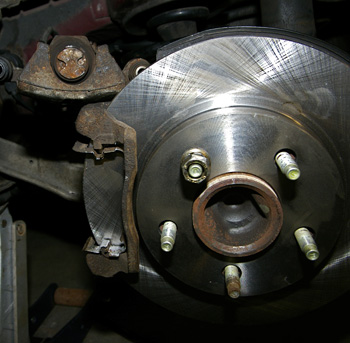 For added NVH suppression, you can apply a nondirectional finish to both sides of the rotor by sanding with a flexible abrasive rotor brush in a drill, or you can block sand both sides of the rotor while it is turning on the lathe with with #120 or #150 grit aluminum oxide sandpaper. Don’t forget to wash off the rotors with warm soapy water afterwards to remove all the debris from the surface (aerosol brake cleaner won’t do a good enough job).
For added NVH suppression, you can apply a nondirectional finish to both sides of the rotor by sanding with a flexible abrasive rotor brush in a drill, or you can block sand both sides of the rotor while it is turning on the lathe with with #120 or #150 grit aluminum oxide sandpaper. Don’t forget to wash off the rotors with warm soapy water afterwards to remove all the debris from the surface (aerosol brake cleaner won’t do a good enough job).
If you are replacing the old rotors with new ones, they should be ready to install right out of the box. There should be no need to resurface brand new rotors because it just removes metal unnecessarily, wastes your time, shortens the life of the rotor, and may increase the risk of a comeback if you end up cutting runout into a new rotor that wasn’t there in the first place.
When you install the pads, make sure you reuse the spring clips or anti-rattle shims (or replace them with new ones if the old ones are damaged, badly corroded or missing).
Be sure to install any shims that come with the new pads. You can also apply a few dabs of high temperature brake lubricant to the backs of the pads where they rest against the caliper piston and caliper mounts to further dampen vibration.
One of the newest aids for reducing NVH are shims that clip onto the face of the caliper piston. The clips perform a two-fold function: they help dampen noise, and they help insulate the caliper piston from heat generated by braking to reduce the risk of fluid boil and pedal fade caused by overheated brake fluid.
Some friction suppliers apply a special surface coating on the face of their brakes pads to help suppress noise while the the pads seat and break-in. Some of these coatings wear away within a few hundred miles or less, while others transfer a film to the rotors that provides long lasting lubrication and noise suppression.
There are also aftermarket brake sprays that can be used for the same purpose. Most of these products create a thin film on the surface of the rotor that helps dampen noise while the pads are seating. The coating doesn’t last very long, but long enough to reduce the risk of pad glazing and noise.
The last thing you should do to make sure NVH isn’t a problem is to test drive the vehicle after you’ve finished the brake job. The 30-30-30 rule for breaking in new pads (30 gradual stops from 30 mph with 30 seconds in between each stop for the brakes to cool) can prevent comebacks from motorists not breaking in their new pads properly. The worst thing anybody can do is a hard panic stop with a new set of unseated brake pads.
OTHER BRAKE-RELATED NVH PROBLEMS
Replacing warped or badly worn rotors with new ones should eliminate a pulsation if the problem was a bad rotor. But, it won’t help if the wobble is due to excessive runout in the hub. So if a customer is complaining about pedal pulsations or vibrations, use a dial indicator to check rotor runout before your replace or resurface the rotors.
Runout is measured by placing the tip of a dial indicator against the outside face of the rotor, then rotating the rotor one full turn. If the dial indicator shows more then 0.003 inches (0.076 mm) of total movement, there’s too much runout. On some vehicles, that number may be as low as 0.002 inches or less.
Runout can sometimes be minimized by simply reindexing the position of the rotor on the hub, or by removing the rotor and cleaning the area where the rotor mates with the hub. If this fails to reduce runout, then the problem is the hub and not the rotor.
Resurfacing the rotors on the vehicle with an on-car lathe may be necessary to get rid of the runout. Or, you may have to replace the hub and wheel bearing assembly.













